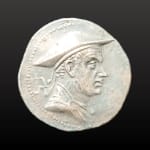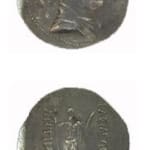Bactrian Tetradrachm of Antimachos I, 185 BC - 170 BC
Silver
Diam. 3.3 cm
Diam. 1 1/4 in
Wt. 16 g
Wt. 1/2 oz
Diam. 1 1/4 in
Wt. 16 g
Wt. 1/2 oz
LC.029
Further images
Obverse: Antimachos I, facing right, diademed and wearing a kausia. Reverse: Poseidon standing, holding a trident and palm frond. Inscr.: ΒΑΣΙΛΕΩΣ ΤΗΕΟΥ ΑΝΤΙΜΑΧΟΥ. Monogram: ΔΤ. Antimachos I Theos, ‘the god’,...
Obverse: Antimachos I, facing right, diademed and wearing a kausia.
Reverse: Poseidon standing, holding a trident and palm frond. Inscr.: ΒΑΣΙΛΕΩΣ ΤΗΕΟΥ ΑΝΤΙΜΑΧΟΥ. Monogram: ΔΤ.
Antimachos I Theos, ‘the god’, is a mysterious figure in the history of the Graeco-Bactrian Kingdom. His reign overlaps with a number of other monarchs, and his relationship to them is hotly contested. He may have been a relative of the reigning Euthydemid Dynasty, but other scholars have proposed that he was a scion of the long-deposed Diodotid Dynasty, the original founders of Bactria. His relationship with the other Diodotid claimant Eukratides was not, however, good, and we can presume that even if he was connected to that family, there was no collaboration between the claimants. The details of his reign are further complicated by a tax receipt, now in the Ashmolean Museum in Oxford (EA 1994.79), which is dated ‘in the reign of Antimachos Theos, Eumenes, and Antimachos [II Nikephoros], year four, in the month of Olous…’ Eumenes and Antimachos II could well be his sons, invited to share power, but others have suggested a kind of associate kingship, or even a divided Bactrian state. Whatever the complex mechanics of power during his short reign, the mysterious Antimachos I Theos is otherwise virtually unknown, appearing only in an exceptional range of coin issues, always alone and never with any reference to co-regents.
The main coin-types of Antimachos are tetradrachms, minted on slight debasement of the Attic standard (16g or 1/2 oz, rather than 17.3 g or 5/8 oz). They follow the standard form of Bactrian coins, with the monarch’s face on the obverse, and a standing god or hero on the reverse, along with the inscription and monogram. Here, Antimachos is presented wearing a simple diadem, with streamers hanging from the back, and a felt hat known as a kausia. A common traveller’s cap, the kausia is the ancestor of the felt hats worn today in Afghanistan (modern pakol) and Armenia. The kausia was a flat-brimmed hat designed to keep the sun out of one’s eyes – its name derives from the Greek kausis, ‘burning’ – and was this perfect for the Bactrian climate. It became so characteristic of the Macedon that the Persians distinguished between ‘the Yauna [Greeks] who live by the sea’ (i.e. on the mainland or islands) and ‘the Yauna who wear hats’ (Macedonians). In Hellenistic monarchies, a purple-dyed kaunia was common headgear for the King. The portrait of Antimachos is of very high quality, indicating that no distinction was made between his portraits and those of more established monarchs.
The reverse bears a standing image of Poseidon. The god is depicted shirtless, bearded and with his himation (cloak) wrapped around his waist, hanging from his hips. He stands in the contrapposto so beloved of the Greek sculptor, and it is possible that a statue of the god formed the model for this figure. In his right hand, he holds a trident, his characteristic attribute, and in his left he holds a palm frond. The palm frond – a symbol of victory, eternal life, and peace (achieved through war) – may reference a specific military victory which led to Antiochos’ accession. Poseidon was clearly not represented on this coin for his oceanic associations; Bactria was entirely landlocked. Instead, he may represent the Indus River, which scholars speculate formed the core of Antiochos’ realm, or perhaps horses, whose importance to the Graeco-Bactrian Kingdom cannot be overstated. Around the standing figure are inscriptions reading basileōs theou Antiochou, ‘of the God-King Antiochos’. This represents something of an escalation on previous Bactrian titularies, and perhaps represents a counterpoint to the coins of the usurper Eukratides, whose coins proclaimed him megas basileus, ‘the Great King’. The overall ensemble of standing figure and columns of text may reference the coins of Demetrios I, perhaps the greatest of the Bactrian monarchs, whose coins bore the image of a standing Herakles. Next to Poseidon’s feet is a monogram consisting of the letters delta and tau. Of disputed meaning, it is possible that the monograms on Bactrian coins were mint marks, assay marks, or signatures of minters.
References: coins of this type, bearing the delta-tau monogram, are found in Oxford (Ashmolean Museum HCR 45180), Paris (Bibliothèque nationale de France R 3681.68, R 3681.69), New York (American Numismatic Society 1967.152.594, 1954.11.1), and Cambridge, Massachusetts (Harvard Art Museums 1972.163).
Reverse: Poseidon standing, holding a trident and palm frond. Inscr.: ΒΑΣΙΛΕΩΣ ΤΗΕΟΥ ΑΝΤΙΜΑΧΟΥ. Monogram: ΔΤ.
Antimachos I Theos, ‘the god’, is a mysterious figure in the history of the Graeco-Bactrian Kingdom. His reign overlaps with a number of other monarchs, and his relationship to them is hotly contested. He may have been a relative of the reigning Euthydemid Dynasty, but other scholars have proposed that he was a scion of the long-deposed Diodotid Dynasty, the original founders of Bactria. His relationship with the other Diodotid claimant Eukratides was not, however, good, and we can presume that even if he was connected to that family, there was no collaboration between the claimants. The details of his reign are further complicated by a tax receipt, now in the Ashmolean Museum in Oxford (EA 1994.79), which is dated ‘in the reign of Antimachos Theos, Eumenes, and Antimachos [II Nikephoros], year four, in the month of Olous…’ Eumenes and Antimachos II could well be his sons, invited to share power, but others have suggested a kind of associate kingship, or even a divided Bactrian state. Whatever the complex mechanics of power during his short reign, the mysterious Antimachos I Theos is otherwise virtually unknown, appearing only in an exceptional range of coin issues, always alone and never with any reference to co-regents.
The main coin-types of Antimachos are tetradrachms, minted on slight debasement of the Attic standard (16g or 1/2 oz, rather than 17.3 g or 5/8 oz). They follow the standard form of Bactrian coins, with the monarch’s face on the obverse, and a standing god or hero on the reverse, along with the inscription and monogram. Here, Antimachos is presented wearing a simple diadem, with streamers hanging from the back, and a felt hat known as a kausia. A common traveller’s cap, the kausia is the ancestor of the felt hats worn today in Afghanistan (modern pakol) and Armenia. The kausia was a flat-brimmed hat designed to keep the sun out of one’s eyes – its name derives from the Greek kausis, ‘burning’ – and was this perfect for the Bactrian climate. It became so characteristic of the Macedon that the Persians distinguished between ‘the Yauna [Greeks] who live by the sea’ (i.e. on the mainland or islands) and ‘the Yauna who wear hats’ (Macedonians). In Hellenistic monarchies, a purple-dyed kaunia was common headgear for the King. The portrait of Antimachos is of very high quality, indicating that no distinction was made between his portraits and those of more established monarchs.
The reverse bears a standing image of Poseidon. The god is depicted shirtless, bearded and with his himation (cloak) wrapped around his waist, hanging from his hips. He stands in the contrapposto so beloved of the Greek sculptor, and it is possible that a statue of the god formed the model for this figure. In his right hand, he holds a trident, his characteristic attribute, and in his left he holds a palm frond. The palm frond – a symbol of victory, eternal life, and peace (achieved through war) – may reference a specific military victory which led to Antiochos’ accession. Poseidon was clearly not represented on this coin for his oceanic associations; Bactria was entirely landlocked. Instead, he may represent the Indus River, which scholars speculate formed the core of Antiochos’ realm, or perhaps horses, whose importance to the Graeco-Bactrian Kingdom cannot be overstated. Around the standing figure are inscriptions reading basileōs theou Antiochou, ‘of the God-King Antiochos’. This represents something of an escalation on previous Bactrian titularies, and perhaps represents a counterpoint to the coins of the usurper Eukratides, whose coins proclaimed him megas basileus, ‘the Great King’. The overall ensemble of standing figure and columns of text may reference the coins of Demetrios I, perhaps the greatest of the Bactrian monarchs, whose coins bore the image of a standing Herakles. Next to Poseidon’s feet is a monogram consisting of the letters delta and tau. Of disputed meaning, it is possible that the monograms on Bactrian coins were mint marks, assay marks, or signatures of minters.
References: coins of this type, bearing the delta-tau monogram, are found in Oxford (Ashmolean Museum HCR 45180), Paris (Bibliothèque nationale de France R 3681.68, R 3681.69), New York (American Numismatic Society 1967.152.594, 1954.11.1), and Cambridge, Massachusetts (Harvard Art Museums 1972.163).







